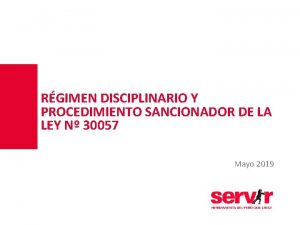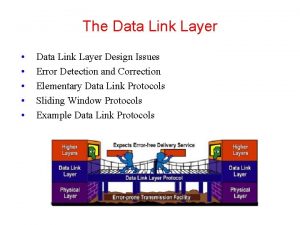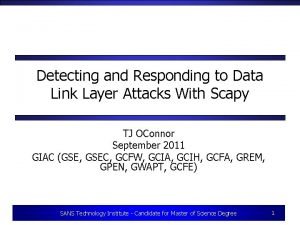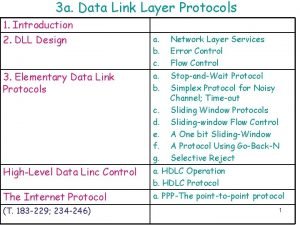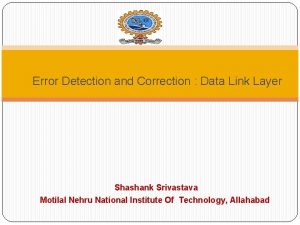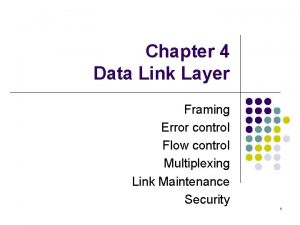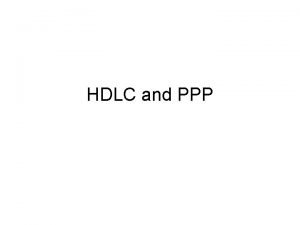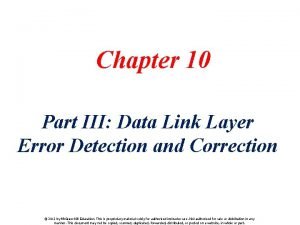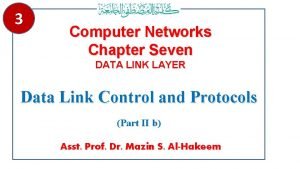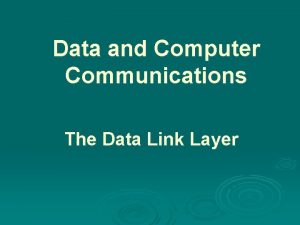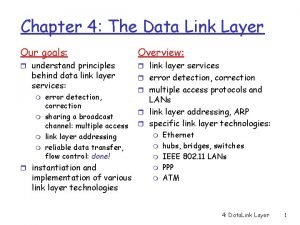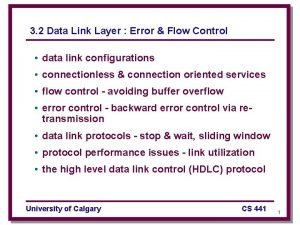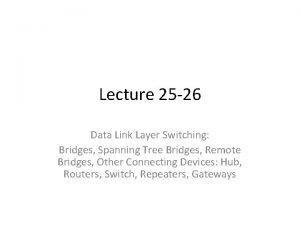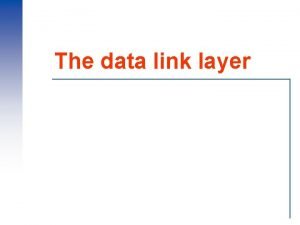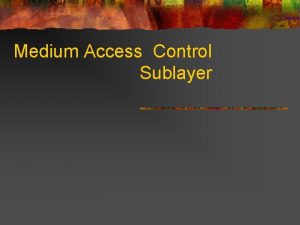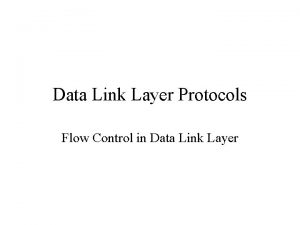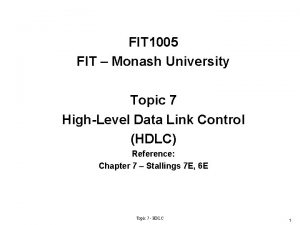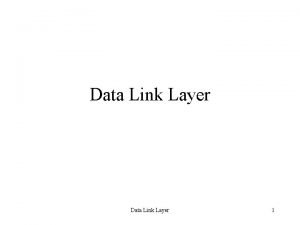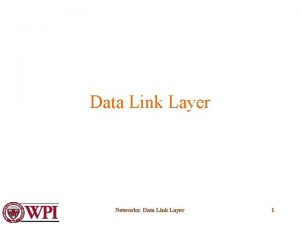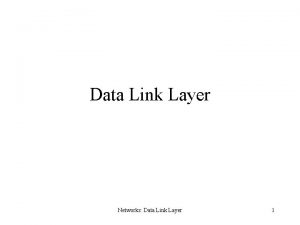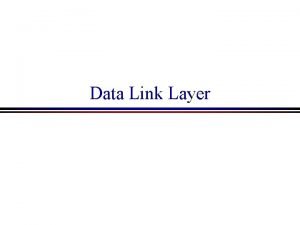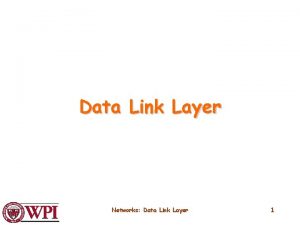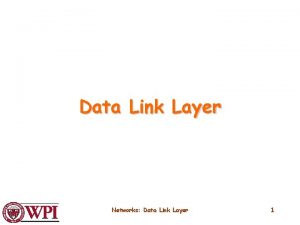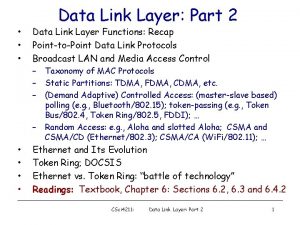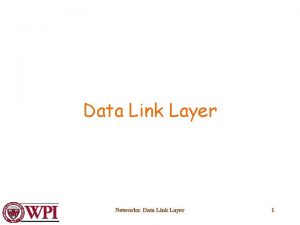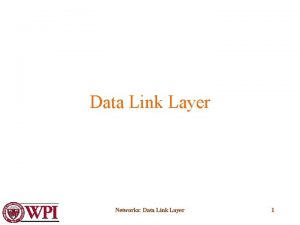FIT 1005 Topic 6 Data Link Layer Reference





























- Slides: 29

FIT 1005 Topic 6 - Data Link Layer Reference: Chapter 7 -Stallings 1

Introduction • Material discussed so far was concerned with sending signals over a transmission link • For effective digital data communications, much more is needed to control and manage the exchange – That is, concerns over sending data over a data communications link • To achieve the necessary control, a layer of logic is added above the physical interfacing – This logic is referred to as data link control or a data link control protocol 2

Introduction Contd. • When a data link control protocol is used, the transmission medium between systems is referred to as a data link • For effective data communication between two directly connected transmitting-receiving stations the following requirements need to be addressed: – Frame synchronisation • The beginning and end of each frame must be recognisable – Flow control • The sending station must not send frames at a rate faster than the receiving station can absorb 3

Introduction Contd. – Error control • Bit errors introduced by the transmission system should be corrected – Addressing • On a multipoint line, such as a LAN, the identity of the two stations involved in a transmission must be specified – Control and data on the same link • The receiver must be able to distinguish control information from the data being transmitted – Link Management • The initiation , maintenance, and termination of a sustained data exchange need to be addressed 4

Flow Control • Flow control is a technique for assuring that a transmitting entity does not overwhelm a receiving entity with data • The receiving entity typically allocates a data buffer of some maximum length for a transfer • When data are received, the receiver must do a certain amount of processing before passing them to the higher layer • In the absence of flow control, the receivers buffer may fill up and over flow 5

Flow Control Contd. 6

Flow Control Contd. • The data are sent in a sequence of frames, with each frame containing a portion of data and some control information • The time it takes for a station to emit all of the bits of a frame onto the medium is the transmission time – This is proportional to the length of the frame • The propagation time is the time it takes for a bit to traverse the link between the source and destination 7

Flow Control Contd. • The simplest form of flow control is known as stop-andwait flow control – A source entity transmits a frame – After the destination entity receives the frame, it indicates its willingness to accept another frame by sending back an acknowledgment to the frame just received – The source must wait until it receives the acknowledgment before sending the next frame • The destination thus can stop the flow of data simply by withholding acknowledgment 8

Flow Control Contd. • The stop-and-wait procedure works fine, but can hardly be improved upon when a message is sent in a few large frames • However, breaking up a large block of data into a smaller number of frames is often the case for the following reasons: – The buffer size of the receiver may be limited – The longer the transmission, the more likely that there will be an error, necessitating retransmission of the entire frame – On a shared medium, such as a LAN, it is usually desirable not to permit one station to occupy the medium for an extended period 9

Flow Control Contd. • With the use of multiple frames for a single message, stop-and-wait procedure may be inadequate • The essence of the problem is that only one frame at a time can be in transit • In situations where the bit length of the link is greater than the frame length, serious inefficiencies result 10

Flow Control Contd. 11

Flow Control Contd. • Efficiency of stop-and-wait procedure can be greatly improved by allowing multiple frames to be in transit at the same time • An operation referred to as sliding-window flow control is used, for flow control, with such improvements • Let us assume that two stations, A and B, are connected via a full-duplex link – Station B allocates buffer space for W frames • Thus B can accept W frames, and A is allowed to send W frames without waiting for any acknowledgment 12

Flow Control Contd. – To keep track of which frames have been acknowledged, each is labelled with a sequence number – B acknowledges a frame by sending an acknowledgment that includes the sequence number of the next frame expected – This acknowledgment also implicitly announces that B is prepared to receive the next W frames, beginning with the number specified – This scheme can also be used to acknowledge multiple frames • B could receive frames 2, 3, and 4, but withhold acknowledgment until frame 4 has arrived 13

Flow Control Contd. • Because the sequence number to be used occupies a field in the frame, it is clearly of bounded size – For example, for a 3 -bit field, the sequence number can range from 0 to 7 • Accordingly, frames are numbered modulo 8, that is, after sequence number 7, the next number is 0 – In general, for a k bit field the range of sequence numbers is through 2 k – 1 and frames are numbered modulo 2 k 14

Flow Control Contd. 15

Flow Control Contd. 16

Flow Control Contd. • In addition to the currently described approaches, most protocols also allow a station to cut off the flow of frames from the other side – This is done by sending a Receive Not Ready (RNR) message, which acknowledges former frames but forbids transfer of future frames • If two stations exchange data, unlike what we have discussed so far, each need to maintain two windows – One for transmit and one for receive, and each side need to send the data and acknowledgment to the other 17

Flow Control Contd. • To provide efficient support for this requirement, a feature known as piggybacking is typically used – Each data frame includes a field that holds the sequence number of that frame plus a field that holds sequence number used for acknowledgment – Thus, if a station has both, data and acknowledgment to send, it sends both together in one frame, saving communication capacity – If a station has only an acknowledgment, it only sends an acknowledgment frame such as RR 18

Error Control • Error control refers to mechanisms to detect and correct errors that occur in transmission of frames • There is possibility of two types of error: – Lost frame • A frame fails to arrive at the other side • A noise burst may damage a frame to the extent that the receiver is not aware that a frame has been transmitted – Damaged frame • A recognisable frame arrives, but some of the bits are in error 19

Error Control Contd. • The most common techniques for error control are based on some or all of the following: – Error detection – Positive acknowledgment – Retransmission after time-out – Negative acknowledgment and retransmission • Collectively, these mechanisms are referred to as automatic repeat request (ARQ) 20

Error Control Contd. • The effect of ARQ is to turn an unreliable data link into a reliable one • The following ARQ versions have been standardised: – Stop-and-Wait ARQ • Based on stop-and-wait flow control technique discussed earlier • The source station transmits a single frame and then must await an acknowledgment (ACK) • No other data frames can be sent until the destination station’s reply arrives at the source station • Two sorts of errors could occur: 21

Error Control Contd. – The frame that arrives at the destination could be damaged » The receiver detects this using an error-detection technique and discards the frame » To account for this possibility, the source station is equipped with a timer » When the acknowledgment is not received before times out, the same frame is sent again » It requires that the transmitter maintain a copy of the transmitted frame until an acknowledgment is received – The second sort of error is a damaged acknowledgment » There will be a time out at the source and the same frame will be resent 22

Error Control Contd. » The destination therefore accepts two copies of the same frame as if they were separate » To avoid this problem, frames are alternatively labelled with 0 or 1, and positive acknowledgments are of the form ACK 0 and ACK 1 • The principal advantage of stop-and-wait ARQ is its simplicity • Its principal disadvantage is that stop-and-wait is an inefficient mechanism 23

Error Control Contd. Stop-and-Wait ARQ 24

Error Control Contd. – Go-back-N ARQ • This is the most commonly used form of error control based on sliding-window flow control • If the destination station detects an error in a frame, it may send a negative acknowledgment (REJ=reject) for that frame – The destination frame will discard that frame and all future incoming frames until the frame in error is correctly received – Thus, the source station, when it receives a REJ, must retransmit the frame in error plus all succeeding frames that were transmitted in the interim 25

Error Control Contd. 26

Error Control Contd. – Selective-Reject ARQ • The only frames retransmitted are those that receive a negative acknowledgment, in this case called SREJ, or those that time out • This ARQ appear to be more efficient than go-back-N, as it minimises the amount of retransmission • On the other hand, the receiver must maintain a buffer large enough to save post-SREJ frames until the frame in error is retransmitted – Must also contain logic for reinserting that frame in the proper sequence – The transmitter must also require more complex logic to be able to send a frame out of sequence 27

Error Control Contd. • Because of above complications, select-reject ARQ is much less widely used than go-back-N ARQ • The Select-reject ARQ is a useful choice for a satellite link because of the long propagation delay involved 28

Error Control Contd. 29
 Memory allocation policy
Memory allocation policy Worst fit memory allocation
Worst fit memory allocation Industrial-cabling-infrastructure
Industrial-cabling-infrastructure Informe técnico 1466-2017-servir-gpgsc
Informe técnico 1466-2017-servir-gpgsc Data link layer design issues
Data link layer design issues Materi data link layer
Materi data link layer Karmetasploit
Karmetasploit Layer data link
Layer data link Data link layer switching in computer networks
Data link layer switching in computer networks Data link layer protocols
Data link layer protocols Data link layer design issues in computer networks
Data link layer design issues in computer networks Error detection and correction in data link layer
Error detection and correction in data link layer Data link layer design issues
Data link layer design issues Data link layer framing
Data link layer framing Data link control
Data link control Data link layer
Data link layer Data link layer design issues
Data link layer design issues Block coding in data link layer
Block coding in data link layer Data link layer protocols for noisy and noiseless channels
Data link layer protocols for noisy and noiseless channels Responsibilities of data link layer
Responsibilities of data link layer Unacknowledged connectionless service
Unacknowledged connectionless service Dlc in data link layer stands for
Dlc in data link layer stands for Unrestricted simplex protocol in data link layer
Unrestricted simplex protocol in data link layer Flow control layer
Flow control layer The two main functions of the data link layer are
The two main functions of the data link layer are Data link layer switching
Data link layer switching One bit sliding window protocol
One bit sliding window protocol Data link osi layer
Data link osi layer Channel allocation problem in data link layer
Channel allocation problem in data link layer Unrestricted simplex protocol program in c
Unrestricted simplex protocol program in c



